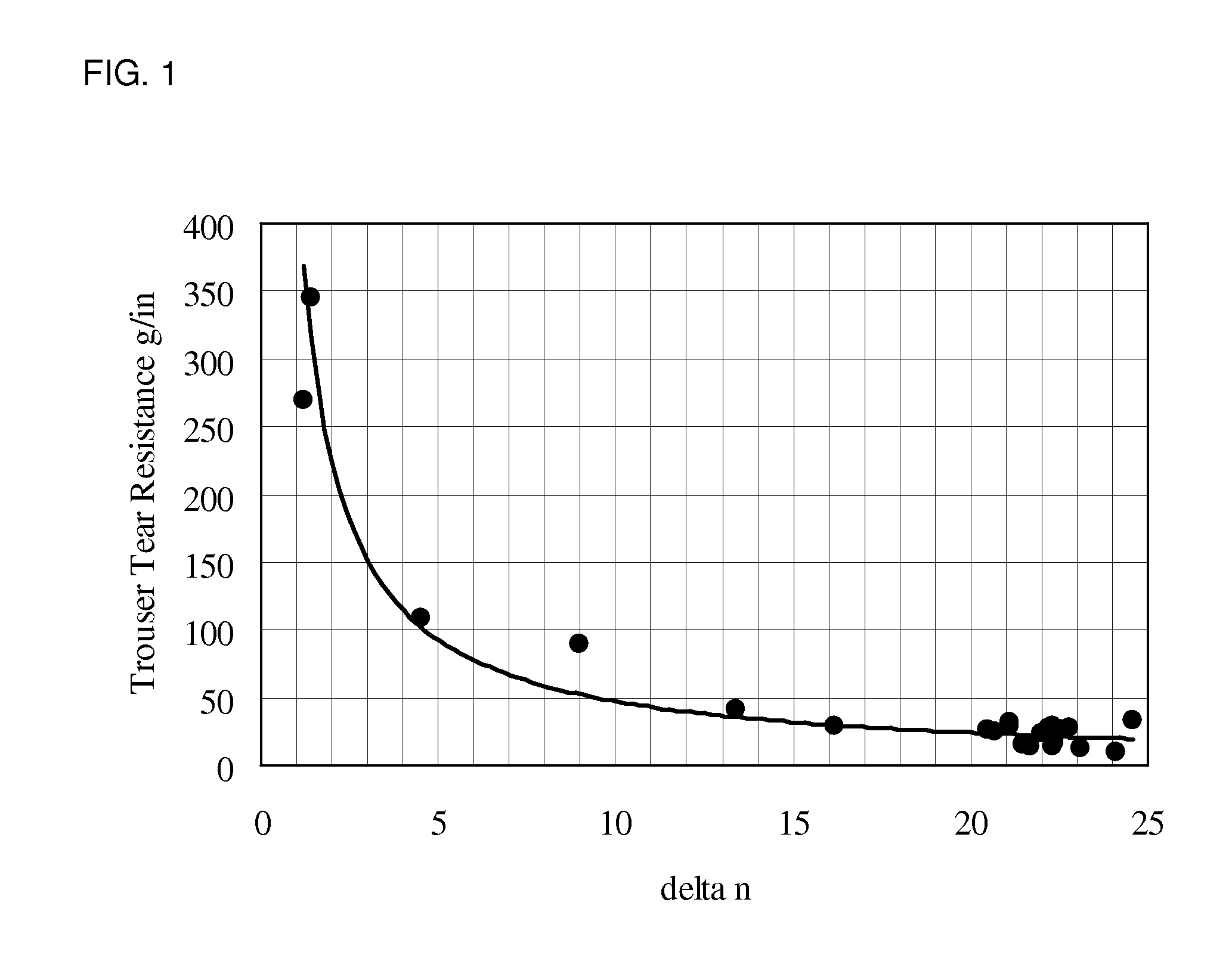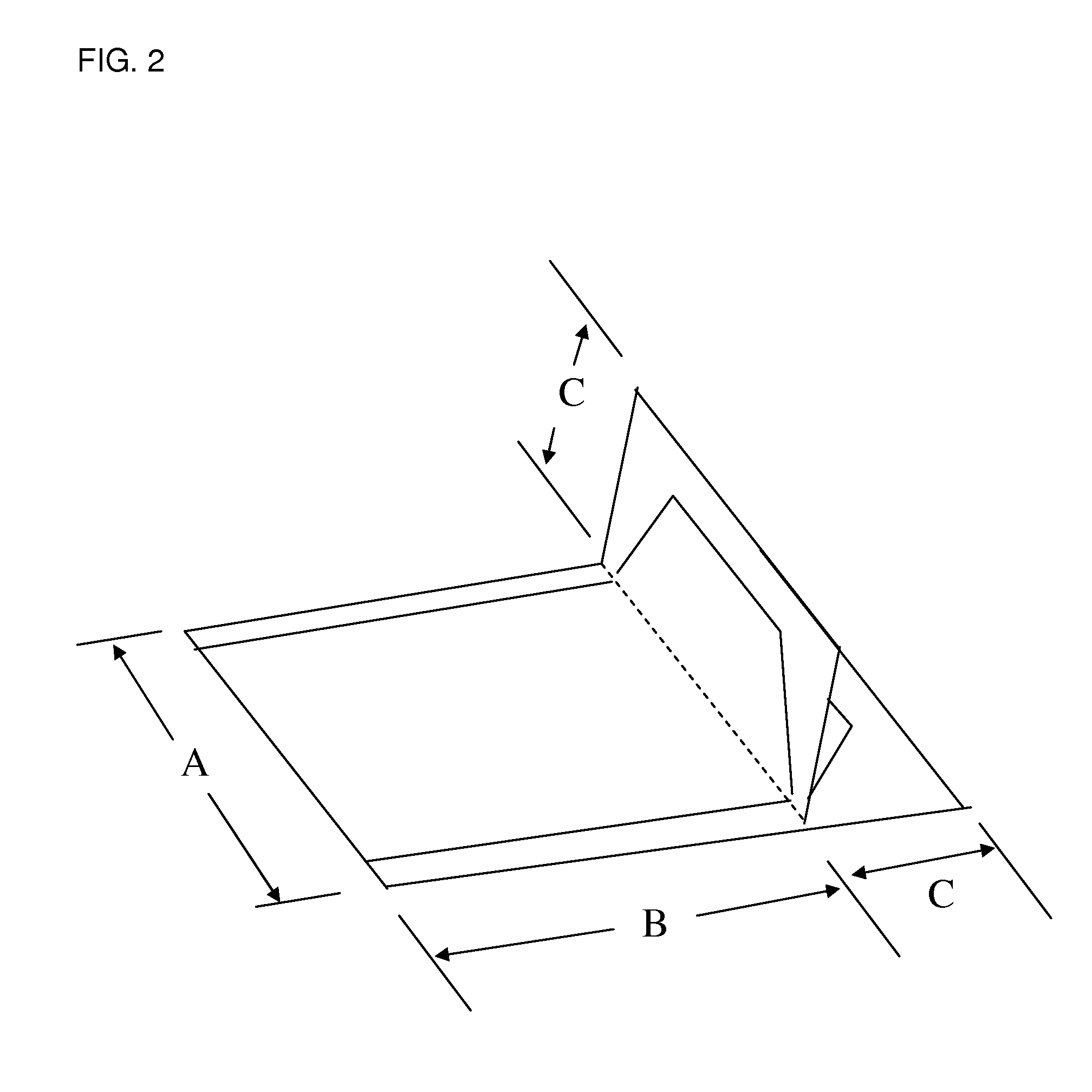Heat sealable monoaxially oriented propylene-based film with directional tear
a propylene-based film, monoaxial orientation technology, applied in the direction of packaging foodstuffs, packaged goods, other domestic articles, etc., can solve the problems of loss or spillage of contents during opening, difficulty for consumers to open pouches by hand, and save transportation costs, so as to achieve excellent hermetic seal properties and better seal properties
- Summary
- Abstract
- Description
- Claims
- Application Information
AI Technical Summary
Benefits of technology
Problems solved by technology
Method used
Image
Examples
example 1
[0076]The resin components were dry-blended together at the ratio shown in Table 1 and extruded in a single layer using a single screw extruder at nominal 260° C. and cast and quenched on a matte finish chill roll at nominal 25° C. The obtained cast sheet was monoaxially oriented in the machine direction by roll stretching at preheat / stretching temperatures of the rolls and at the MD stretching ratio as shown in Table 1. The stretched film was sequentially cooled down and annealed in the same MD machine at 90° C. The total thickness of this film substrate after monoaxial orientation was ca. 80 μm. The film was passed through a corona treater for discharge treatment (4 kW) on one side of the film and wound into roll form. The film was tested for refractive index, directional tear performance and heat sealability properties. As shown in Table 2, the film of Example 1 has a refractive index delta n of 21.5 and average Trouser tear of 15 g / in, indicating excellent directional tear. This...
examples 2 to 5
[0077]Example 1 was repeated except that the mixed resin blend and MD stretching conditions were modified as shown in Table 1 for additional Examples 2 through 5. These additional Examples used slightly different ratios of the same materials as Ex. 1 as noted (e.g. Examples 4 and 5), and were stretched at the same stretching temperature conditions as Ex. 1. Machine direction orientation ratios, however, were varied from Ex. 1, targeting higher ratios than that used in Ex. 1, from 5.8 to 7.0. As shown in Table 2, Ex. 2 to 5 exhibited similar delta n values, Trouser tear values, and satisfactory SIT and heat seal strengths as Ex. 1.
examples 7 to 16
[0078]Examples 7 to 13 evaluated use of blends of propylene homopolymer, block copolymer, and elastomer at varying stretching temperatures and ratios. Generally, stretching ratios were lower than Ex. 1 (except for Ex. 7), varying from 5.0 to 3.5. As shown in Table 2, Examples 7 to 13 show that the refractive index delta n is comparable to Example 1; Trouser tear values are slightly higher than Ex. 1; and qualitative tear rating is slightly worse. However, tear values are still very satisfactory. SIT is very good, same as Ex. 1, and heat seal strength is also very good, generally better than Ex. 1. The higher seal strengths may be attributable to the use of the propylene homopolymer and block copolymer blend.
[0079]Examples 14 to 16 explored the same resin formulation as the previous Examples 7 to 13 in this set but at much lower MD orientation ratios of 3.0 to 2.0. As Table 2 shows, these Examples showed a lower delta n refractive index value significantly lower than the previous Exa...
PUM
| Property | Measurement | Unit |
|---|---|---|
| wt % | aaaaa | aaaaa |
| refractive index | aaaaa | aaaaa |
| heat sealable | aaaaa | aaaaa |
Abstract
Description
Claims
Application Information
 Login to View More
Login to View More - R&D
- Intellectual Property
- Life Sciences
- Materials
- Tech Scout
- Unparalleled Data Quality
- Higher Quality Content
- 60% Fewer Hallucinations
Browse by: Latest US Patents, China's latest patents, Technical Efficacy Thesaurus, Application Domain, Technology Topic, Popular Technical Reports.
© 2025 PatSnap. All rights reserved.Legal|Privacy policy|Modern Slavery Act Transparency Statement|Sitemap|About US| Contact US: help@patsnap.com



